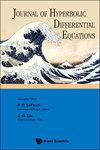Energy scattering for a class of inhomogeneous nonlinear Schrödinger equation in two dimensions
IF 1.1
4区 数学
Q4 MATHEMATICS, APPLIED
引用次数: 13
Abstract
We consider a class of [Formula: see text]-supercritical inhomogeneous nonlinear Schrödinger equations in two dimensions [Formula: see text] where [Formula: see text] and [Formula: see text]. Using a new approach of Arora et al. [Scattering below the ground state for the 2D radial nonlinear Schrödinger equation, Proc. Amer. Math. Soc. 148 (2020) 1653–1663], we show the energy scattering for the equation with radially symmetric initial data. In the focusing case, our result extends the one of Farah and Guzmán [Scattering for the radial focusing INLS equation in higher dimensions, Bull. Braz. Math. Soc. (N.S.) 51 (2020) 449–512] to the whole range of [Formula: see text] where the local well-posedness is available. In the defocusing case, our result extends the one in [V. D. Dinh, Energy scattering for a class of the defocusing inhomogeneous nonlinear Schrödinger equation, J. Evol. Equ. 19(2) (2019) 411–434], where the energy scattering for non-radial initial data was established in dimensions [Formula: see text].一类二维非齐次非线性Schrödinger方程的能量散射
我们考虑一类二维超临界非齐次非线性薛定谔方程[公式:见正文],其中[公式:看正文]和[公式:看看正文]。使用Arora等人的一种新方法[二维径向非线性薛定谔方程的基态以下散射,Proc.Amer.Math.Soc.148(2020)1653–1663],我们展示了具有径向对称初始数据的方程的能量散射。在聚焦情况下,我们的结果将Farah和Guzmán[高维径向聚焦INLS方程的散射,Bull.Braz.Math.Soc.(n.S.)51(2020)449–512]的结果扩展到[公式:见正文]的整个范围,其中局部适定性是可用的。在散焦情况下,我们的结果扩展了[V.D.Dinh,一类散焦非均匀非线性Schrödinger方程的能量散射,J.Evol.Equ.19(2)(2019)411–434]中的结果,其中非径向初始数据的能量散射是在维度上建立的[公式:见正文]。
本文章由计算机程序翻译,如有差异,请以英文原文为准。
求助全文
约1分钟内获得全文
求助全文
来源期刊

Journal of Hyperbolic Differential Equations
数学-物理:数学物理
CiteScore
1.10
自引率
0.00%
发文量
15
审稿时长
24 months
期刊介绍:
This journal publishes original research papers on nonlinear hyperbolic problems and related topics, of mathematical and/or physical interest. Specifically, it invites papers on the theory and numerical analysis of hyperbolic conservation laws and of hyperbolic partial differential equations arising in mathematical physics. The Journal welcomes contributions in:
Theory of nonlinear hyperbolic systems of conservation laws, addressing the issues of well-posedness and qualitative behavior of solutions, in one or several space dimensions.
Hyperbolic differential equations of mathematical physics, such as the Einstein equations of general relativity, Dirac equations, Maxwell equations, relativistic fluid models, etc.
Lorentzian geometry, particularly global geometric and causal theoretic aspects of spacetimes satisfying the Einstein equations.
Nonlinear hyperbolic systems arising in continuum physics such as: hyperbolic models of fluid dynamics, mixed models of transonic flows, etc.
General problems that are dominated (but not exclusively driven) by finite speed phenomena, such as dissipative and dispersive perturbations of hyperbolic systems, and models from statistical mechanics and other probabilistic models relevant to the derivation of fluid dynamical equations.
Convergence analysis of numerical methods for hyperbolic equations: finite difference schemes, finite volumes schemes, etc.
 求助内容:
求助内容: 应助结果提醒方式:
应助结果提醒方式:


